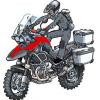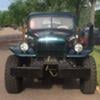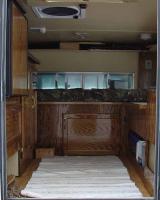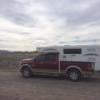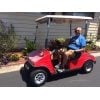A stripped Eagle shell weighs about 545 pounds. Gas milege is affected by turbulance or drag created when the vehicle moves through the air. If a curved aluminum wind deflector (like the one on the Four-Runner roof rack) was installed across the back roof (above the door) of the camper you would see an improvement in mpg.
Speed also affect milege. When truck is loaded for camping. Driving at 60 mph produces 18 + mpg on our rig. (One drives 55-60 mph in Oregon). At 70 highway milege drops to 16-16.5. Pulling the Samurai we average 14.5 at 60 mph.
Manxman, Since you are retired and like to tinker a good project would be "fabbing" a wind deflector. Mounting it and reporting on the results with pictures.....If you buy an ATC/FWC shell.
I certainly don't want to turn this thread into an aerodynamics discussion...but, here is my 2 cents.
The idea that an air dam or similar device on top of the cab of a pickup will appreciatively improve fuel mileage (more than 1 MPG) is simply not the case.
I use airframe aerodynamics for the following discussion. But, whether a land or air vehicle is really irrevalent for this discussion.
Prior to retiring as a Boeing 777 pilot I was introduced ("fire hose" introduction) to modern aircraft design/aerodynamics (the 787 is a quantitive aerodynamic leap beyond the 777). Boeing has demonstrated aerodynamic design for improved fuel economy and range is not simply addressing/minimizing the displacement of air in the front of the vehicle, but also (and equally important) minimizing the mixing of smooth and turbulent air as it passes over the vehicle. As such Boeing designs attempt to minimize the disruption of laminar air flow. Minimizing the disruption of the air flow over the vehicle ultimately reduces turbulence and the size of the low pressure area aft the vehicle which is as important as minimizing the disruption of the air flow at the front.
Why? A large low pressure area created by turbulent air aft of the vehicle will be equally if not more influential in degrading fuel economy and ultiamtely range. The use of an air dam on top of the cab will only create more turbulent air and enlargen the size of the low pressure area aft of the vehicle. Wind tunnel studies show that air dams significantly disrupt boundary layer air creating even larger areas of turbulence and vortices, thus enlargening the low pressure area aft of the vehicle.
Recall the trucking industry used air dams on top of the cab for a number of years until cab designs included aerodynamic profiles. Just like modern airplane designs with "butter knife" tails to retain laminar flow, reducing turbulent air and the size of the low pressure area aft of the of the fuselage, 18 wheel truck rigs are now showing up with deployable "turkey feathers" installed aft of the rear doors. All to reduce turbulent air and the size of the low pressure area aft of the vehicle.
IMO, without doing exhaustive research, I think an air dam on the cab of a pickup is a non-factor, if not a degradation to overall vehicle aerodynamics; even with a FWC camper in the bed.
Performing an "on the road" evaluation will not be scientifically supportive due to constantly changing environmental and road conditions. Wind tunnel testing in a highly controlled environemnt is the only method to either support or debunk the installation of an air dam over the cab of a pickup truck with a slide-in camper.
But, in the end, individual perception is half the battle. If one feels an air dam helps, by all means install one.
Finally, engine RPM due to axle (gear) ratio determines fuel economy at any given speed. Ford, Chevy and Dodge offer a range of axle ratios based on the need and intended use of the buyer. If purchasing a new truck for your FWC camper, be sure to look at a suitable axle ratio for your predominate driving style.
Edited by Advmoto18, 02 June 2015 - 12:05 PM.




